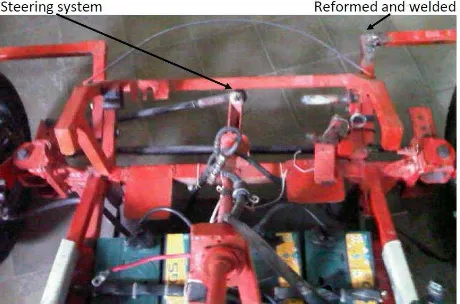International Journal of Mechanical & Mechatronics Engineering IJMME-IJENS Vol:16 No:03 166
167003-8989-IJMME-IJENS © June 2016 IJENS
I J E N S
Design and Modeling of Hydraulic Crash Damper in
a Racing Electric Vehicle
Ahmad Syuhri
Department of Mechanical Engineering, Faculty of Engineering, University of Jember, Jember, Indonesia E-mail: [email protected]
Abstract— Since racing vehicle has greater risk of injury and vehicle damage than any others urban vehicle, this paper presents the design, modeling and performance study of crash damper in a racing electric vehicle. Using lumped parameter model (LPM) as analytical approach, the development model of hydraulic crash damper is used to absorb or to dissipate the kinetic energy on frontal crash. The mathematical model between initial model and development model is derived to obtain responses of both vehicle and occupant. Plot 3D surface from numerical simulation is used to obtain optimum value of development model. The results in time response are also plotted to compare both initial model and development model. Development model also claimed that can reduce in vehicle deceleration, occupant deceleration and vehicle deformation in the range of 25% to 28.1% than initial model.
Index Term— hydraulic crash damper, lumped parameter model, vehicle occupant deceleration, deformation vehicle.
I. INTRODUCTION
Nowadays, student competitions in the racing vehicles are growing rapidly. The competition itself encourages students to design and to build their own vehicle. The product must be compact and well calculated due to many risks in both driver and vehicle. The greater velocity that occurs in racing competitions can make driver injury and vehicle damage [1]. Mostly the damage is coming from a frontal crash that directly affected on steering systems. Figure 1 shows the front bumper has been reformed due to frontal crash in an electric vehicle competition. Before it reformed, the right bumper displaced and forced the tire. So the steering system can’t be actuated until the bumper is well repaired. Unfortunately, the repairment process needs to be welded. This situation is time consuming, that’s why there must be any add-ons in a bumper design to absorb energy, masses and overall lengths of colliding vehicles.
Fig. 1. Front bumper has been reformed after frontal crash
To obtain the best bumper design, it must meet and fulfill five requirements as follows, (1) be replaceable without cutting or welding, (2) absorb energy and restrict damage to the bumper system only, (3) be attached to the body via energy absorbing structure that are inexpensive to repair or replace, (4) be stable during impact and (5) prevent damage to the structure [2]. Recently, there are two categories in the development of bumper to absorb energy, either deformation elements (“crash boxes”) or a reversible type (“shock
absorber”) [3]. The primary disadvantages of deformation
element is opposite with the best bumper design point (1) and (5) such as it needs longer time to be replaced after the crash and the deformation can destruct the shape of structures. In the other hand, the reversible type or known as shock absorber, which is mentioned as hydraulic crash damper in this paper, has more advantages than crash boxes. It gives easily to re-stretched or re-extended after crash which can save some times during the competition, and this device also claimed to generate a constant deceleration [4].
There are several analytical models to analyze the behaviors between bumper, vehicle structure and occupant under impact mode such as lumped parameter models (LPM), beam element model (BED) and finite element models (FEM) [5]. LPM is reported as the simplest and efficient tools to analyses vehicle structures and concepts in energy absorbing elements at design stages [6]. The responses of crash in a vehicle can also be compared with a range of performance such as optimal vehicle deceleration crash pulse where contained of time acceleration history in three intervals based on the occupant interactions with the vehicle [4]. Moreover, the deformation of frontal vehicle body must not be exceeded than 0.7 m [6], and the occupant performance in crash mode also obtained at the peak deceleration of the occupant mass [7].
